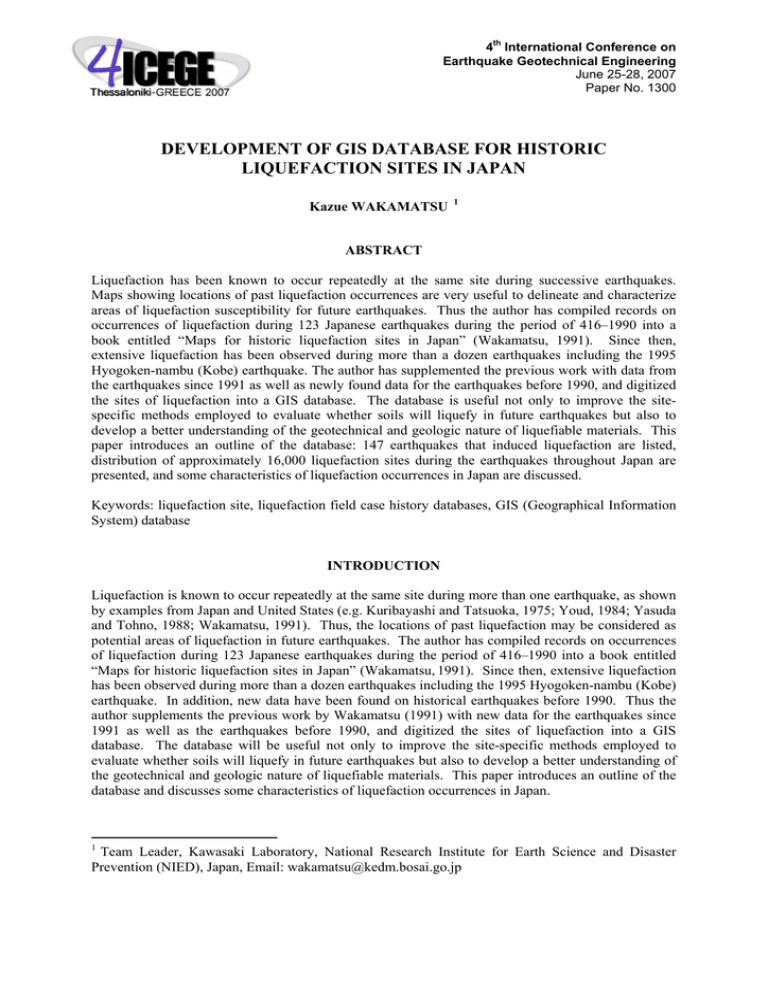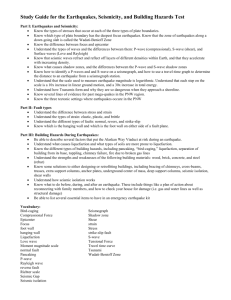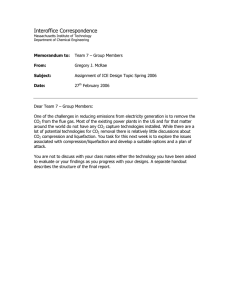DEVELOPMENT OF GIS DATABASE FOR HISTORIC LIQUEFACTION SITES IN JAPAN
advertisement

4th International Conference on Earthquake Geotechnical Engineering June 25-28, 2007 Paper No. 1300 DEVELOPMENT OF GIS DATABASE FOR HISTORIC LIQUEFACTION SITES IN JAPAN Kazue WAKAMATSU 1 ABSTRACT Liquefaction has been known to occur repeatedly at the same site during successive earthquakes. Maps showing locations of past liquefaction occurrences are very useful to delineate and characterize areas of liquefaction susceptibility for future earthquakes. Thus the author has compiled records on occurrences of liquefaction during 123 Japanese earthquakes during the period of 416–1990 into a book entitled “Maps for historic liquefaction sites in Japan” (Wakamatsu, 1991). Since then, extensive liquefaction has been observed during more than a dozen earthquakes including the 1995 Hyogoken-nambu (Kobe) earthquake. The author has supplemented the previous work with data from the earthquakes since 1991 as well as newly found data for the earthquakes before 1990, and digitized the sites of liquefaction into a GIS database. The database is useful not only to improve the sitespecific methods employed to evaluate whether soils will liquefy in future earthquakes but also to develop a better understanding of the geotechnical and geologic nature of liquefiable materials. This paper introduces an outline of the database: 147 earthquakes that induced liquefaction are listed, distribution of approximately 16,000 liquefaction sites during the earthquakes throughout Japan are presented, and some characteristics of liquefaction occurrences in Japan are discussed. Keywords: liquefaction site, liquefaction field case history databases, GIS (Geographical Information System) database INTRODUCTION Liquefaction is known to occur repeatedly at the same site during more than one earthquake, as shown by examples from Japan and United States (e.g. Kuribayashi and Tatsuoka, 1975; Youd, 1984; Yasuda and Tohno, 1988; Wakamatsu, 1991). Thus, the locations of past liquefaction may be considered as potential areas of liquefaction in future earthquakes. The author has compiled records on occurrences of liquefaction during 123 Japanese earthquakes during the period of 416–1990 into a book entitled “Maps for historic liquefaction sites in Japan” (Wakamatsu, 1991). Since then, extensive liquefaction has been observed during more than a dozen earthquakes including the 1995 Hyogoken-nambu (Kobe) earthquake. In addition, new data have been found on historical earthquakes before 1990. Thus the author supplements the previous work by Wakamatsu (1991) with new data for the earthquakes since 1991 as well as the earthquakes before 1990, and digitized the sites of liquefaction into a GIS database. The database will be useful not only to improve the site-specific methods employed to evaluate whether soils will liquefy in future earthquakes but also to develop a better understanding of the geotechnical and geologic nature of liquefiable materials. This paper introduces an outline of the database and discusses some characteristics of liquefaction occurrences in Japan. 1 Team Leader, Kawasaki Laboratory, National Research Institute for Earth Science and Disaster Prevention (NIED), Japan, Email: wakamatsu@kedm.bosai.go.jp IDENTIFICATION OF LIQUEFACTION OCCURRENCES To search for records of liquefaction effects, various kinds of materials on earthquake damage, such as reports, papers, web site contents, and ancient documents for all of Japan, were collected. Descriptions of liquefaction effects were picked up from these documents, and the sites where liquefaction took place were identified based on these descriptions. In addition, in several earthquakes the author conducted post-earthquake reconnaissance investigations, aerial photo interpretation, and interviews with local residents. In the investigations, occurrences of liquefaction were identified by observed sand and water boiling and/or floating up of buried structures, but observed fissures, lateral spreading, ground subsidence, and settlement of structures without sand and/or water boiling were excluded from the signs of liquefaction effect. EARTHQUAKES THAT CAUSED LIQUEFACTION Up to the present, approximately 1,000 destructive earthquakes have been recorded in various kinds of historical materials and seismic data in Japan (Usami, 2003). The oldest of the earthquakes is the earthquake of August 23, 416, which was documented in the “Nihon Shoki”, an authorized historical document of Japan. These 1,000 earthquakes during the period of 416–2006 in Japan were investigated in this study. They include about 500 earthquakes prior to 1884, which are documented in nonscientific materials, and more than 500 recent earthquakes that took place after 1884, when nationwide earthquake observation was started in Japan. Instances of liquefaction evidence such as sand dike in the ground, which were revealed by archeological excavation, are excluded from the liquefaction sites in this study, for the dates of earthquakes that induced liquefaction can be difficult to identify. The investigation revealed that a total of 147 events have induced liquefaction at a total of 16,082 sites from 416 to 2006, including the original 123 earthquakes previously presented by the author. These 147 earthquakes are summarized in Table 1. The JMA (Japan Meteorological Agency) magnitude, MJ, of the earthquakes that induced liquefaction ranges from 5.2 to 8.6. The oldest event that was identified to induce liquefaction is the 745 earthquake that occurred in Gifu Prefecture, located in the central part of the main island of Japan, whereas the latest one is the Miyagiken-oki earthquake of August 16, 2005, which attacked the Sendai area in the northern part of the main island of Japan. Since 1884, when systematic earthquake observation began in Japan, 87 earthquakes have generated liquefaction. Thus liquefaction has occurred approximately twice in every three years somewhere in Japan during the last 123 years. In the Table, the number of liquefaction sites in every earthquake is also listed; the total number of liquefaction sites in all 147 earthquakes reached 16,082. It is especially large, 8083 and 1770, for No. 135, the earthquake of January 17, 1995, in Hyogoken-nambu, and No. 144, the earthquake of October 23, 2004, in Niigata-ken Chuetsu, respectively. This is because the liquefaction data for these earthquakes are especially complete as they contain the results of detailed surveys obtained by the interpretation of aerial photographs taken immediately after the earthquake, as well as because of the strong ground motion intensity and liquefaction susceptibility of the subsurface soil deposits in the affected areas. Earthquakes Nos. 52 and 53 occurred on Dec. 23 and 24 of the same year, in quick succession; therefore it is difficult to identify which shock triggered the occurrence of the liquefaction in some areas located between the epicenters of the two earthquakes. Thus liquefaction sites during these earthquakes were combined in the database, and the number of the sites for the two earthquakes are counted as a single total in Table 1. . Table 1. Earthquakes which Induced Liquefaction during the Period of 416–2006 No. Date 1 n.d., 745 2 n.d., 850 3 July 10, 863 4 August 13, 1185 5 Oct. 9, 1257 6 May 13, 1449 7 July 9, 1498 8 Jan. 18, 1586 9 Sep.1, 1596 10 Sep.5, 1596 11 Feb. 3, 1605 12 March 1, 1633 13 Oct. 18, 1644 14 June 16, 1662 15 Feb. 1, 1666 16 Oct. 7, 1685 17 June 19, 1694 18 Dec. 12, 1694 19 Dec. 31, 1703 20 May 27, 1704 21 Oct. 28, 1707 22 May 13, 1717 23 n.d.1717 24 Dec. 19, 1723 25 March 8, 1729 26 n.d.,1734 27 Jan. 3, 1738 28 March 26, 1751 29 May 21, 1751 30 Oct. 31, 1762 31 March 8, 1766 32 Aug. 29, 1769 33 June 11, 1774 34 August 23, 1782 35 May 21, 1792 36 Feb. 8, 1793 37 June 29, 1799 38 Nov. 18, 1802 39 July 10, 1804 40 Sep. 25, 1810 41 August 2, 1819 42 Dec. 18, 1828 43 August 19, 1830 44 Nov. 13, 1831 45 Dec. 7, 1833 46 Feb. 9., 1834 47 April 22, 1841 48 April 25, 1843 49 May 8, 1847 Location, JMA magnitude lat.(°N), long.(°E) 7.9* 7.0* 7.4* 7.3* 6.1* 7.3* 6.1* 7.0* 7.5* 7.9 7.0* 6.5* 7.4* 6.8* 7.0* 8.1* 7.0* 8.6 7.5* 6.3* 6.5* 5,5* 5.8* 7.2* 7.0* 7.3* 7.8* 7.0* 6.4* 7.0* 6.0* 6.8* 7.0* 6.5* 7.3* 6.9 6.5* 7.5* 6.4* 6.3* 7.5* 7.4 35.2 39.0 35.00 35.20 35.00 33.00 35.00 33.30 34.80 33.50 35.20 39.40 35.30 37.10 40.20 34.70 40.40 33.20 38.50 36.50 32.90 37.00 35.00 37.10 38.10 40.70 33.00 35.40 32.80 40.85 36.60 35.20 39.05 39.90 35.20 37.60 35.10 38.90 43.30 35.00 42.00 36.70 136.6 139.7 135.80 139.50 135.75 132.25 135.75 131.60 135.40 138.50 139.20 140.00 135.90 138.20 140.10 139.80 140.00 135.90 142.50 136.50 130.60 138.7 135.80 138.20 138.70 140.50 132.10 139.10 130.30 139.95 136.70 136.50 139.95 139.90 136.30 138.90 135.60 139.25 141.40 138.50 146.00 138.20 Depth (km) - Earthquake name Epicentral region Number of liquefaction sites** (1) (1) (1) 1 1 (1) (1) (1) (1) Keicho Genroku Houei 1 1 1 1 3 1 1 10 1 3 (4) 1 7 1 (1) 1 1 (1) (1) (1) 2 3 4 1 1 1 1 3 3 (1) Kisakata 37 (4) 1 5 55 2 (1) Zenkohji 1 1 2 1 52 (10) Table 1. Earthquakes which Induced Liquefaction during the Period of 416–2006 (cont.) No. Date 50 51 52 53 54 55 56 57 58 59 60 61 62 63 64 65 66 67 68 69 70 71 72 73 74 75 76 77 78 79 80 81 82 83 84 85 86 87 88 89 90 91 92 93 94 95 96 97 98 May 13, 1847 July 9, 1854 Dec. 23, 1854 Dec. 24, 1854 March 15, 1855 Nov. 7, 1855 Nov. 11, 1855 August 23, 1856 April 9, 1858 Jan. 5, 1859 March 14, 1872 July 22, 1887 July 28, 1889 Jan. 7, 1890 Oct. 28, 1891 Jan. 3, 1892 Sep. 7, 1892 Sep. 7, 1893 Jan. 10, 1894 June 20, 1894 Oct. 22, 1894 Jan. 18, 1895 August 31, 1896 Jan. 17, 1897 Feb. 20, 1897 April 3, 1898 April 23, 1898 May 26, 1898 August 10, 1898 Sep. 1, 1898 March 7, 1899 August 9, 1901 May 8, 1904 June 2, 1905 August 14, 1909 March 15, 1914 Dec. 8, 1922 Sep. 1, 1923 May 23, 1925 July 4, 1925 March 7, 1927 August 6, 1927 Oct. 27, 1927 Oct. 17, 1930 Nov. 26, 1930 Sep. 21, 1931 Sep. 21, 1933 July 11, 1935 Feb. 21, 1936 Location, JMA magnitude lat.(°N), long.(°E) 6.5* 7.3* 8.4 8.4 7.3* 7.1* 7.5* 7.1* 6.2* 7.1* 5.7 6.3 6.2 8.0 5.5 6.1 5.3 6.3 7.0 7.0 7.2 7.2* 5.2 7.4 6.2 7.2 6.1 6.0 7* 7.0 7.2 6.1 7.2 6.8 7.1 6.9 7.9 6.8 5.7 7.3 6.7 5.2 6.3 7.3 6.9 6.0 6.4 6.4 37.20 34.75 34.00 33.00 34.50 35.65 41.00 36.40 34.80 35.15 37.50 32.80 36.45 35.60 35.30 35.70 31.40 35.40 35.70 38.90 36.10 39.50 36.65 38.10 34.60 38.60 37.00 33.60 24.50 34.10 40.50 37.10 34.10 35.40 39.50 32.70 35.33 35.56 35.35 35.63 37.90 37.50 36.30 35.04 36.16 37.12 35.01 34.49 138.30 136.10 137.80 135.00 137.75 139.80 142.50 137.20 131.90 132.10 138.90 130.65 137.95 136.60 137.10 137.00 130.50 136.70 139.80 139.90 140.40 140.70 138.25 141.90 131.20 142.00 138.90 130.20 124.75 136.10 142.50 138.90 132.50 136.30 140.40 130.10 139.14 134.84 133.42 134.93 142.17 138.85 136.35 138.98 139.28 136.83 138.40 135.72 Depth (km) 23.0 0.0 0.0 20.0 25.0 0.0 0.0 2.0 0.0 30.0 9.0 19.0 Earthquake name Epicentral region Number of liquefaction sites** 3 26 (1) Ansei Tokai Ansei Nankai Edo Hamada Koshi-gun Kumamoto Saigawa-ryuiki Nohbi Aftershock of of Nohbi Aftershock of of Nohbi Chiran Aftershock of of Nohbi Tokyo-wan Hokubu Shonai Kasumigaura-fukin Riku-u Naganoken hokubu Sendai-oki Mishima Miyagiken-oki Miyagiken-oki Fukuoka Yaeyama-gunto Kii-hanto nanseibu Aomoriken-oki Muikamachi Geiyo Gohno (Anegawa) Akita Senpoku Chijiwa-wan Kanto Kita-Tajima Miho-wan Kita-Tango Miyagiken-oki Sekihara Daishoji Kita-Izu Nishi-Saitama Noto-hanto Shizuoka Kawachi-Yamato 84 (8) 1 6 12 (1) 1 123 1 53 (1) 1 1 227 (18) 3 (1) 1 87 27 (1) 50 6 48 (2) 16 4 1 1 1 10 (1) 1 8 1 1 120 3 4 850 15 2 19 1 1 2 7 127 6 10 14 Table 1. Earthquakes which Induced Liquefaction during the Period of 416–2006 (cont.) 99 Nov. 3, 1936 Kinkazan-oki 7.5 36.26 142.07 61.0 3 100 May 1, 1939 Oga 6.8 39.94 139.75 2.0 14 (1) 101 July 15, 1941 Nagano 6.1 36.68 138.15 7.0 9 102 March 4, 1943 Tottori-oki 6.2 35.44 134.14 2.0 12 103 Sep. 10, 1943 Tottori 7.2 35.47 134.19 0.0 90 104 Dec. 7, 1944 Tohnankai 7.9 33.57 136.18 40.0 478 (1) 105 Jan. 13, 1945 Mikawa 6.8 34.70 137.11 10.0 156 106 Dec. 21, 1946 Nankai 8.0 32.93 135.85 24.0 43 (1) 107 Sep. 27, 1947 Ishigakijima 7.4 24.70 123.20 95.0 1 108 June 28, 1948 Fukui 7.1 36.17 136.30 0.0 170 (1) 109 March 4, 1952 Tokachi-oki 8.2 41.80 144.13 0.0 15 110 March 7, 1952 Daishoji-oki 6.5 36.48 136.20 0.0 2 111 July 27, 1955 Tokushimaken nanbu 6.4 33.73 134.32 10.0 1 112 Oct. 19, 1955 Futatsui 5.9 40.27 140.18 0.0 1 113 Feb. 2, 1961 Nagaoka 5.2 37.45 138.84 0.0 3 114 Feb. 27, 1961 Hyuganada 7.0 31.64 131.89 37.0 2 115 April 23, 1962 Hiroo-oki 7.1 42.46 143.77 69.0 2 116 April 30, 1962 Miyagiken hokubu 6.5 38.74 141.14 19.0 7 117 May 7, 1964 Ogahanto-oki 6.9 40.39 138.67 24.0 18 118 June 16, 1964 Niigata 7.5 38.37 139.22 23.0 268 (1) 119 Feb. 21, 1968 Ebino 6.1 32.02 130.72 0.0 2 120 April 1, 1968 Hyuganada 7.5 32.28 132.53 0.0 3 121 May 16, 1968 Tokachi-oki 7.9 40.73 143.58 20.0 78 122 June 17, 1973 Nemurohanto-oki 7.4 42.97 145.95 25.0 5 123 Jan. 14, 1978 Izu-Ohshima kinkai 7.0 34.77 139.25 0.0 1 124 Feb. 20, 1978 Miyagiken-oki 6.7 38.75 142.20 0.0 1 125 June 12, 1978 Miyagiken-oki 7.4 38.15 142.17 2.0 52 126 March 21, 1982 Urakawa-oki 7.1 42.07 142.60 0.0 22 127 May 26, 1983 Nihonkai chubu 7.7 40.36 139.08 30.0 335 (1) After shock, Nihonkai chubu 128 June 21, 1983 8 7.1 41.26 139.00 9.0 129 Dec. 17, 1987 Chibaken toho-oki 6.7 35.37 140.50 19.0 331 130 Jan. 15, 1993 Kushiro-oki 7.5 42.92 144.36 61.0 303 131 Feb. 7, 1993 Notohanto-oki 6.6 37.65 137.30 2.0 76 132 July 12, 1993 Hokkaido-nansei-oki 7.8 42.78 139.18 7.0 506 133 Oct. 4, 1994 Hokkaido-toho-oki 8.2 43.37 147.68 2.0 198 (4) 134 Dec. 28, 1994 Sanriku-haruka-oki 7.6 40.43 143.75 0.0 90 135 Jan. 17, 1995 Hyogoken-nambu (Kobe) 7.3 34.60 135.04 40.0 8,083 136 March 26, 1997 Kagoshimaken hokuseibu 20 (2) 6.6 31.97 130.36 10.0 137 May 13, 1997 Kagoshimaken hokuseibu 6.4 31.94 130.31 24.0 11 138 Feb. 26, 1999 Akitaken-oki 5.3 39.15 139.84 95.0 8 139 Oct. 06, 2000 Tottoriken-seibu 7.3 35.27 133.35 0.0 418 140 March, 24, 2001 Geiyo 6.7 34.13 132.70 0.0 34 141 May, 26, 2003 Miyagiken-oki 7.1 38.82 141.65 0.0 27 142 July, 26. 2003 Miyagiken-hokubu 6.4 38.43 141.17 10.0 29 143 Sept. 26, 2003 Tokachi-oki 8.0 41.78 144.08 0.0 148 144 Oct. 23, 2004 Niigata-ken Chuetsu 6.8 37.29 138.87 0.0 1,770 145 Nov. 29. 2004 Kushiro-oki 7.1 42.15 145.05 37.0 3 146 March 20, 2005 Fukuokaken seiho-oki 7.0 33.12 130.03 69.0 88 147 Aug. 16, 2005 Miyagiken-oki 7.2 38.15 142.28 19.0 15 -: earthquake focal depth is unknown *: mean value of the estimated range of the earthquake magnitude **: Numbers in parentheses represent liquefaction sites for which detailed information is not available. LIQUEFACTION DATABASE FOR ALL OF JAPAN The liquefaction data whose locations could be identified were mapped and digitized using GIS software. The data set contains the coordinates, place name, and source reference for each liquefaction site and the date, magnitude, epicenter, and focal depth of the earthquake that induced the liquefaction. Figure 1 plots liquefaction sites attributed to all 147 earthquakes for which locations of liquefaction could be identified. Except in a few cases, the liquefaction sites are located on low-lying areas whose subsurface ground consists of Holocene alluvial deposits or artificial fills. In some areas, such as Tokyo, Nagoya Akita, and Niigata, liquefaction has been observed in more than five successive earthquakes up to the present. Figure 1. Distribution of liquefaction sites during 416–2006 Figure 2 shows the distribution of liquefaction sites in the Tokyo metropolitan area; liquefaction was observed during six successive earthquakes: the 1855 Edo (MJ 7.1), the 1894 Tokyo-wan hokubu (MJ7.0), the 1895 Kasumigaura (MJ 7.2), the 1923 Kanto (MJ 7.9), the 1931 Nishi-Saitama (MJ 6.9), and the 1987 Chibaken Toho-oki (MJ 6.7). The liquefaction sites are distributed along the river and coast in flat and low-lying areas SEISMIC INTENSITY AT LIQUEFACTION SITES The extent of liquefaction in a susceptible area can be easily estimated in an earthquake based on seismic intensity if a correlation is established between past liquefaction occurrences and seismic intensity. Figure 3 shows several examples of distributions of liquefaction sites and seismic intensities on the JMA scale during the earthquakes in the Tokyo metropolitan area. The correlation of different seismic intensity scales including JMA and other intensity scales are shown in Figure 4. Most of the liquefaction sites in each earthquake are located within the zones of JMA intensity V and greater, which is almost equivalent to VIII on the Modified Mercalli (M.M.) scale. However, minor cases of liquefaction occurred at intensities lower than V. The subsurfaces of the sites where liquefaction occurred at intensities lower than V presumably consist of the deposits most susceptibleto liquefaction, although the earthquake shaking of these sites may be locally stronger. N Tokyo Chiba Yokohama Figure 2. Liquefaction sites during the past earthquakes in Tokyo metropolitan area Intensity IV Intensity IV V V V IV VI VI V VI a) 1894 Tokyo-wan hokubu (MJ7.0) b) 1923 Kanto (MJ 7.9) III IV III Intensity V V Intensity IV IV III V III c) 1931 Nishi-Saitama (MJ 6.9) d) 1987 Chibaken Toho-oki (MJ 6.7) Figure 3. : Distribution of seismic intensity (after Usami, 2003) and liquefaction sites XII XI X XI VII VI IX IX V VIII VIII IX VII VII VIII VI VI VII V V VI V IV IV IV III III III II II II IV III X XII X II I 0 I I I J.M.A. scale M.M. scale M.S.K. scale R.F. scale Figure 4. Correlation of different seismic intensity scales (Seismological Division, JMA, 1971) CONCLUDING REMARKS Liquefaction sites during the past earthquakes were investigated for all of Japan and digitized into a GIS database. The investigation revealed that: a total of 147 events with magnitudes ranging from 5.2 to 8.6 have induced liquefaction during the past approximately 16 centuries; approximately 16,000 sites of liquefaction appeared in most parts of Japan due to the earthquakes; most of them are located on low-lying areas underlain by liquefiable Holocene sediments and artificial fills; and the liquefaction in area around Tokyo was induced by seismic shaking with an intensity of V and greater on the JMA scale. Currently, the contents and format of the database are being checked and adjusted. The database will be released on the Internet and/or on CD-ROM in the future. The database will be useful not only to improve the site-specific methods employed to evaluate whether soils will liquefy in future earthquakes but also to developing a better understanding of the geotechnical and geologic nature of liquefiable materials. ACKNOWLEDGEMENTS The work presented in this paper was supported by the Special Project for Earthquake Disaster Mitigation in Urban Areas from the Ministry of Education, Culture, Sports, Science and Technology of Japan. The author gratefully acknowledges this support. She also thanks Dr. Masashi Matsuoka who created the datasets of the distributions seismic intensity presented in Figure 3. REFERENCES Kuribayashi, E. and Tatsuoka, F. "Brief Review of Soil Liquefaction during Earthquakes in Japan", Soils and Foundations, 15-4, 81-92, 1975. Seismological Division, J.M.A. "The Records of Seismic Intensity Observed in Japan," Technical Report of Japan Meteorological Agency, 76, 1971 (in Japanese) Usami, T. Materials for Comprehensive List of Destructive Earthquakes in Japan, 416-2001, Univ. of Tokyo Press., Tokyo , 2003 (in Japanese). Wakamatsu, K. Maps for Historic Liquefaction Sites in Japan, Tokai Univ. Press, Tokyo, 341p., 1991 (in Japanese with English abstract). Wakamatsu, K., Kubo, S., Matsuoka, M., Hasegawa, K. and Sugiura, M. Japan Engineering Geomorphologic Classification Map, University of Tokyo Press, Tokyo, 104p., 2005 (in Japanese with English abstract, GIS data in CD-ROM). Yasuda, S. and Tohno, I. "Sites of Reliquefaction Caused by the Nihonkai-Chubu Earthquake", Soils and Foundations, 28-2, 61-72, 1988. Youd, T. L. "Discussion of Brief Review of Liquefaction during Earthquakes in Japan by E. Kuribayashi and F. Tatsuoka", Soils and Foundations,17-1, 82-85, 1977. Youd, T.L. "Recurrences of Liquefaction at Same Site", Proc., 8th World Conf. on Earthquake Engineering, San Francisco, 3, 231-238, 1984.





